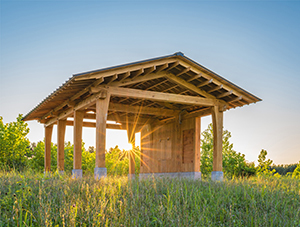
The Morrison Family Education and Outreach Pavilion, the inaugural building at the University of Notre Dame’s Linked Experimental Ecosystem Facility (ND-LEEF) at St. Patrick’s County Park, received a 2015 Citation Award from the American Institute of Architects (AIA) Indiana. Constructed in October 2014, the pavilion is the first University structure to receive a commendation from AIA Indiana Design Awards.
The Morrison Pavilion was recognized in AIA’s new construction category for projects costing less than $1 million. The four-member AIA Jury commented on the pavilion: “We were impressed with every detail and choice made in the design of this structure. The decision to orient the building along the summer solstice, and to situate it with its back to the approach, a simple swath of mown meadow, was poetic.”
The pavilion also received “high commendation” for Excellence in Design in Community Engagement from the International Network of Traditional Architecture and Urbanism at its World Congress event in London last spring. The Midwest Chapter of the Institute of Classical Architecture and Classical America will recognize the pavilion with an Acanthus Award in November.
“We are very proud of the recognition that the pavilion has received, most notably for being a structure that both demonstrates and celebrates the critical relationship between the built and natural environment,” said Aimee Buccellato, assistant professor of architecture. “It stands — quite literally — for what we at the Environmental Change Initiative stand for: pairing research with outreach that will have the greatest possible impact while causing the least amount of harm to the environment.”
Buccellato designed the pavilion using traditional timber framing construction methods. The timber for the frame, mostly native white and bur oak, was felled in western Illinois then transported for milling and fabrication before the live-build raising event.
The Morrison Pavilion includes a touch-screen display, showcasing the research underway at ND-LEEF to visitors as well as the story about the design and construction of the distinctive pavilion. The interactive multimedia component will soon be powered by solar cells mounted to the roof of the pavilion.
Part of the Notre Dame Environmental Change Initiative, ND-LEEF is a globally unique research facility with two replicated watersheds and linked streams, ponds and wetlands. The 29-acre site was designed to bridge the controlled environment of a laboratory with the uncontrolled environment found in nature.
As the centerpiece of ND-LEEF, the Morrison Family Education and Outreach Pavilion offers a year-round outdoor classroom and outreach destination located 5 miles from campus at St. Patrick’s County Park.
“St. Joseph County Parks strives to promote understanding and stewardship of the community’s natural and cultural heritage, and the Morrison Pavilion expands our ability to provide new experiences for our park visitors, school groups and adult learners,” said Evie Kirkwood, director of St. Joseph County Parks. “We are honored to collaborate with the University of Notre Dame and thrilled that AIA is recognizing the superb design of this unique facility within St. Patrick’s County Park.”
The pavilion serves as a platform for the public, University visitors and academic peers to learn of the cutting-edge research being conducted by scientists, and acts as the gateway between the classroom and the field for educators and students of all ages.
“ND-LEEF provides a unique experimental platform to enhance research around major environmental challenges facing society today. The Morrison Pavilion provides a physical location that enhances translation of this research,” said Jennifer Tank, Galla Professor of Biological Sciences and director of ND-LEEF. “In addition, the pavilion is an elegant example of sustainable design and construction practices that minimize society’s impact on the environment, exemplifying the Environmental Change Initiative’s commitment to ‘Science Serving Society.’”
Originally published by at news.nd.edu on October 28, 2015.